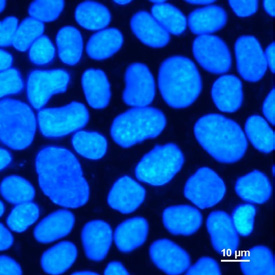Smart and Healthy Living
Living cells and microelectronics: a replacement for animal experiments
Where possible, biomedical research now replaces animal experiments with test systems that use biomolecules isolated from organs or tissue. In-vitro assays of this type, however, are insufficient when it comes to showing the complex interactions within a real organism. Researchers at Fraunhofer EMFT are deploying living cells in the assays and using microelectronic tools to monitor and analyze them.


In many biomedical areas, such as testing new medications, in-vitro tests with isolated biomolecules have reduced or even replaced animal tests in the early stages of development. And this is not just for ethical reasons: one great advantage of these in-vitro model systems is that they can be carried out with high throughput and in reproducible laboratory conditions. Often, the complex biological system is replaced with individual, isolated, purified receptor molecules (proteins, nucleic acids) in order to ensure that the number of molecular components involved remains manageable. Then, over a set period, the experiment is monitored to see whether and how the active ingredient being tested binds to the receptor molecules. The disadvantage is that this simplified model does not allow the complex conditions and processes within a real organism to be accurately reproduced.
Living cells as a “happy medium”
Researchers at the Fraunhofer Research Institution for Microsystems and Solid State Technologies EMFT in Regensburg are pursuing a promising alternative approach: as a sort of “happy medium” between animal testing and purified molecules, they are using living cells for their tests. These have many different receptors on their surface and signaling chains inside them that allow them to detect and react to various molecules in their environment. The research team’s approach is based on capturing how the cell reacts to the test substance being bound to the receptors – and on using the cell in this manner as a high-sensitivity test system for bioactivity or toxicity testing.
The cells are applied – either individually or in the form of a tissue compound – to the surface of a physical signal converter such as metal or polymer electrodes on which they can grow. Instead of looking at the binding of an active ingredient to a target molecule in the cell, the Regensburg-based research team analyzes the reaction of thecells to this stimulus. This may include the vitality, the speed of cell division, the speed of cell migration, or changes in the cell volume. This process is not only much closer to the complexity of real conditions, it also has additional advantages: the reaction to an experimental stimulus (chemicals, pharmaceuticals, microorganisms) without the use of additional reagents (label-free) can be followed for individual time periods of between milliseconds and several days.
Wide usage spectrum for medical engineering and pharmacology
The areas of application for these cell-based sensors range from basic medical engineering issues and drug development to toxicity testing and regenerative medicine. One current example with great potential is the culture of cardiac muscle cells on stainless steel electrodes. The rhythmic beating of the cells is registered in a time-resolved manner by measuring the electrode impedance, which allows new pharmaceuticals to be tested with regard to a possible effect on the heartbeat.
About the project:
Since January 1, 2017, the development and adjustment or optimization of cell-based sensors and/or assays have been part of the services offered by Fraunhofer EMFT. The team at the Regensburg location offer consultancy regarding detection principles, materials selection, the functionalization and integration thereof into individual test environments, as well as data analysis and feasibility studies for special assay formats and technologies.
Last modified: